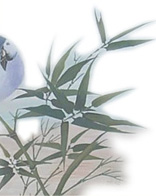|
 LISTEN-SONG BY SHIRLEY LISTEN-SONG BY SHIRLEY
 Hi, friends, today I would like to introduce a Chinese Northeast folk "Yao Lanqu", in English is "Lullaby" for you.:-) I am sure all of us had heard a "Lullaby" when we were babies. Here, I would like to help you to know something about Chinese mothers, how do they sing Lullabies for their babies, what do they wish their children to be in the future and how do they help their children to get sleepy... :-) Hi, friends, today I would like to introduce a Chinese Northeast folk "Yao Lanqu", in English is "Lullaby" for you.:-) I am sure all of us had heard a "Lullaby" when we were babies. Here, I would like to help you to know something about Chinese mothers, how do they sing Lullabies for their babies, what do they wish their children to be in the future and how do they help their children to get sleepy... :-)
This song was sung by one of the most famous Chinese folk musicians -- Ms. Peng Liyuan first time. The lyrics and music were written by Mr. Zhen Jianchun.
MAIN MEANING OF THIS LULLABY LISTEN-SONG BY SHIRLEY: LISTEN-SONG BY SHIRLEY:
The moon is bright,
the wind is quiet,
leaves are cover the window lattices.
Crickets are singing "zheng zheng",
just like the sounds from the strings.
Music is light,
tone is lovely,
cradle is waving lightly.
Mom's baby,
closes your eyes,
you are getting sleepy in a dream.
Little doves,
opening their winging to fly.
they are keeping singing "Gu Gu".
Little baby in the dream,
you are smiling now.
Your eyebrow is comeliness,
your face is red,
just like a little hero.
Little hero will be a soldier,
to make contributions for the motherland.
Dews cover flowers,
the flowers out of window are red.
flowers are bloosing,
flowers are red,
baby you have to grow up.
The moon is bright,
the wind is quiet,
crickets are keeping singing,
Mom's baby,
closes your eyes,
you are sleeping in a dream...
 CHINSE PRONUNCIATION CHINSE PRONUNCIATION LISTEN-SONG BY SHIRLEY LISTEN-SONG BY SHIRLEY
Yue4 er ming2,
feng1 er jing1,
shu4 ye4 zhe1 chuang1 ling2 a.
Qu1 qu1 jiao4 "zheng zheng",
hao3 bi3 na4 qing2 xiang2 sheng1 a.
Xian1 er (na4 ge4) qing1,
tiao4 er dong4 ting1,
yao2 lan2 qing1 bai3 dong4 a.
Niang2 de bao3 bei4,
bi4 shang4 yan3 qing1,
shui4 le shui4 zai4 na4 ge4 meng4 zhong1 a.
Xiao3 ge1 zi,
zhan3 chi4 fen1,
"Gu Gu" jiao4 lian2 sheng1 a.
Xiao3 bao3 bei3,
shui4 meng4 zhong1,
wei1 wei1 de lou4 le xiao4 rong2 a.
Mei2 er (na4 ge4) qing1,
lian3 er (na4 ge4) hong2,
hao3 xiang4 ge xiao3 ying2 xiong2.
Xiao3 ying1 xiong2,
yao4 qu4 dang1 bing1,
wei4 le zuo3 guo2 li4 da4 gong1 a.
Lu4 shuo3 er,
sa3 hua1 er,
chuang1 qian2 de hua1 er hong1.
Hua1 er kai1,
hua1 er hong2,
bao3 bao3 ni3 jiu4 yao4 cheng2 zhang3 a.
Yue4 er ming2,
feng1 er jing4,
Qu1 qu1 jiao4 lian2 sheng1 a.
Niang2 de bao3 bei4,
bi4 shang4 yan3 qing1,
shui4 le shui4 zai4 na4 ge4 meng4 zhong1 a.
Please notice there are many "er" and "a" in this folk, this is one of the characteristics of this song and North east folks’. They are used in the sentences to help to express the mother' feeling to her child, there is no any actual meaning.
Also, in this song, mother was read "Niang2"instead of "Ma Ma" as I have told you in another song. Mother can be read "Ma1", "Ma1 Ma1", also can be "Niang2"or "A Ma1" in different Chinese dialects.
Ok, just hope my singing can help you to practice your Chinese aural comprehension and also help you to know something more about Chinese Folk music and literature :-)
 If you have any questions, comments, suggestions and requisitions, please write to shirley@ebridge.cn, you are welcomed. If you have any questions, comments, suggestions and requisitions, please write to shirley@ebridge.cn, you are welcomed.
--Shirley
Written on Thurs., Sep 15, 2005
Edited and Recorded on Sat., Sep 17, 2005
|

